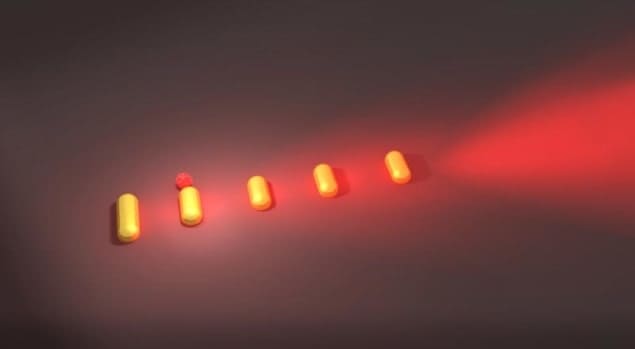
Nanotechnology offers the promise of a new wave of sensors and optical components, but the tiny sizes involved can make it difficult for users to exchange information with these devices. Now, researchers in Spain have demonstrated a novel solution to this problem that involves fixing an “antenna” to nanoscale objects that can send and receive optical data with high precision.
physicsworld.com first reported this idea earlier in the year when researchers in Japan announced that they had created a nanoscale version of the famous “Yagi Uda” antenna. This device was invented in the 1920s to overcome signal degradation, which caused radio signals to lose quality over distance. It was used by the British with radar during the Second World War and went on to become the standard antenna for transmitting and receiving television signals.
Key to the classic design is its “parasitic elements”, made from strips of electrical conductors. These elements induce currents in the presence of a radio signal, which, in turn, generate secondary radio signals that can be transmitted in the same direction as the original signal. The same principle works in reverse so the antenna can boost a signal when receiving information.
Honey I shrunk the antenna
In the nanoscale version of the Yagi Uda antenna, the conducting strips are replaced by an array of gold nanorods. The nanorods are aligned in such a way that incoming light manages to trigger plasmons in the gold surface – that is, collective wavelike motions of billions of electrons – to resonate and emit secondary light in the same direction. The researchers in Japan argued that their device could lead to new sensors – providing that it could be coupled to light-emitting particles.
This feat has now been achieved by Niek van Hulst and colleagues at the Institute for Photonic Sciences (ICFO) in Barcelona together with researchers at the Catalan Institute for Research and Advanced Studies (ICREA). They fabricated a number of nanoscale Yagi Uda antennas containing the tiny parasitic elements made from gold using lithography to etch the devices onto a glass substrate. The total length of individual antennas was 830 nm where individual feeds were just 145 nm, each separated by 175 nm.
To integrate the antennas with particles, Van Hulst’s team then used lithography a second time to decorate the substrate with quantum dots – nanosized pieces of semiconductor in which electrons (or holes) are confined in 3D such that their electronic properties can be controlled by changing the size of the dots. By positioning the quantum dots close to the gold feed elements, the researchers were able to couple the quantum dots with the near field of the nanoantenna.
A narrow angular cone
With this configuration, Van Hulst’s team was able to show that light emitted from the quantum dots, in the form of luminescence spectra, was being transmitted by the Yagi Uda antennas in a narrow angular cone. “The direction of the interaction between light and matter can now be controlled in an asymmetric way,” says Alberto Curto, a member of the Barcelona-based team. “This step forward in the field of nano-optics has potential applications in quantum optical technologies and the detection of minute amounts of chemicals, for example.”
The researchers also show that it is important to tune the system by creating parasitic elements that match the luminescence spectrum. “We fabricated various antennae of different dimensions and show that resonant tuning between quantum dots and the antenna is important to get the right directivity, just like tuning the classical TV antenna,” Van Hulst told physicsworld.com.
Yutaka Kadoya – a member of the Japanese team that published earlier in the year – is impressed by the speed of this new development and views it as a victory for experimental research. “Nowadays computer simulation is widespread and easily used while the experiments have become tougher and tougher. I think actual progress cannot be expected without experimental investigations.”
Kadoya believes that the next stage in the research is to home in on the quantum dot to investigate the luminescence dynamics.
This research is described in Science.



